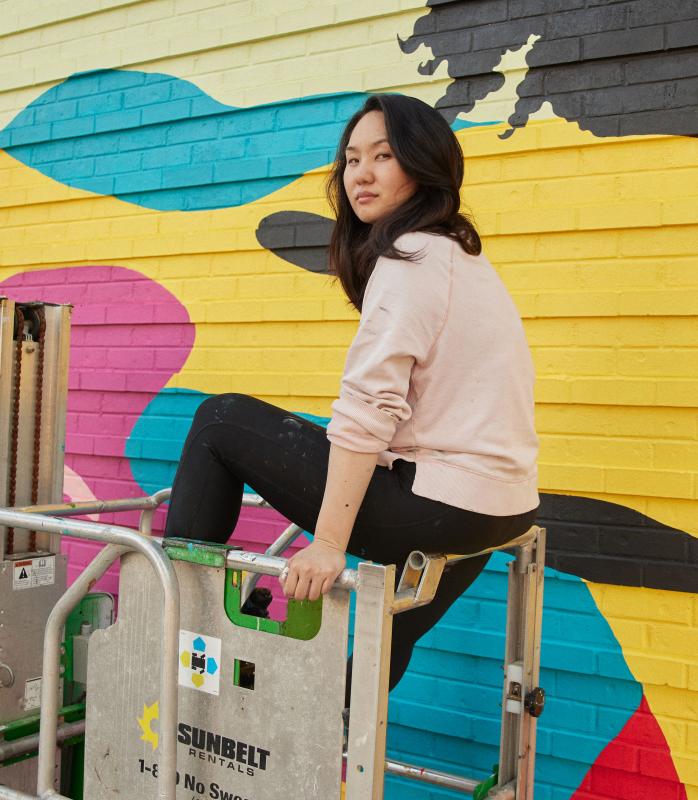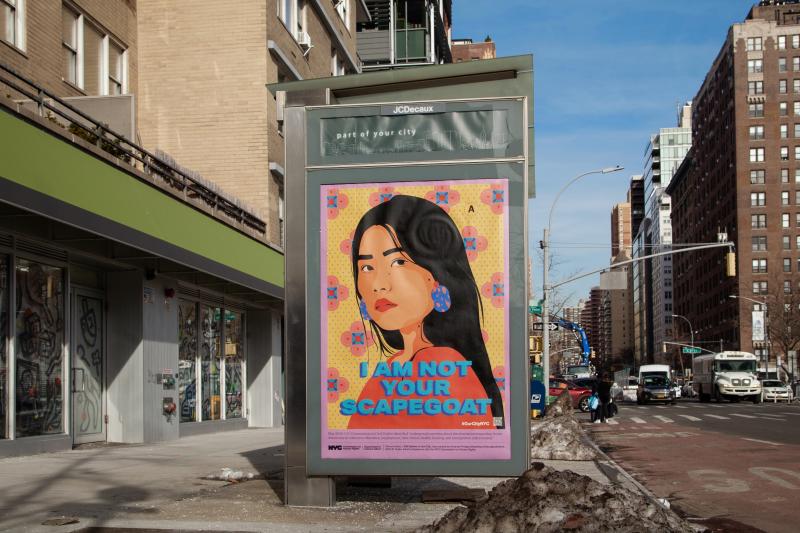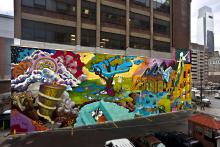Moving Past Liat: Amanda Phingbodhipakkiya Reflects on What It Means to be an Asian American Woman Artist

Multidisciplinary artist Amanda Phingbodhipakkiya working on a mural in Washington, DC. Photo by Will Martinez
When asked about her experience of being an Asian American woman, multidisciplinary artist Amanda Phingbodhipakkiya brings up the character of Liat in the musical South Pacific: “She doesn’t speak. She doesn’t really do much. She’s hardly a full person,” mused Phingbodhipakkiya. She goes on to reflect that “when we are loud and bold and we do big things that reclaim space for our communities, it is shocking and perhaps even threatening in a way because it is so far out of the realm of what people are used to thinking of Asian American women.”
Phingbodhipakkiya is no stranger to being bold. She left her work as a neuroscientist after accepting, as she put it, “I’ve always been an artist at heart.” She uses her artwork not only in service of her own creative expression, but as a tool to elevate undertold stories, whether those of women in science or the roughly 1.2 million Asian Americans who call New York City home.
In 2020, while serving as a New York City public artist-in-residence embedded in the city’s Commission on Human Rights, Phingbodhipakkiya created the I Still Believe in Our City project. Conceived as a response to the spike in anti-Asian hate the nation witnessed during the pandemic, the project installed colorful posters throughout the city of Asian Americans, along with language such as “I did not make you sick” and “I am not your scapegoat”. For Phingbodhipakkiya, painting joyful canvases is not a way of avoiding grief but a way to be resilient in the face of grief. And her work itself is a way of connecting the individual to the community and of claiming her own space and voice in the art world as a way to make a space for and elevate the voices of others.
Here’s Amanda Phingbodhipakkiya with her perspective on being an Asian American woman artist and all that makes possible.
ON BECOMING AN ARTIST
I think I’ve always been an artist at heart. When I saw how prescriptive the avenues available to me might be, I decided to essentially create a path on my own; I think this is probably a path that many artists feel that they’ve been down. My MFA is in design, but I think having worked across so many fields and having a plethora of influences makes me a more thoughtful and a more accessible artist.
For a lot of Asian American women, especially now after the Atlanta shooting [when eight people were killed, six of whom were Asian American women, in March 2021], there’s been a sort of awakening, and it’s unleashed this tidal wave of energy and advocacy and power and resilience and strength that’s just really exciting to see. Of course, artists who may not have turned their work toward activism are starting to go there. I think even technology workers, knowledge workers, everyone is wanting to do something, and art has such power in that sense.
As artists, we can harness the power of our art to amplify joy and soothe grief and move people to action. I think my work is a manifestation of what I hope for my community, and all of our communities; that we are able to have joy, and have peace, and have moments of resistance that aren’t just protest. While my practice is deeply rooted in story, it’s also very much an exploration of the transformation of pain and grief and anger into new paths forward that are full of joy and light. I think joy is a beautiful act of resistance. To have it, and to hold it unabashedly, is something we all deserve.

Amanda Phingbodhipakkiya’s poster “I am not your scapegoat” as part of the I Still Believe in Our City project in New York City, one of a hundred unique pieces. Photo by MK Luff
ON THE EXPERIENCE OF BEING AN ASIAN AMERICAN WOMAN ARTIST
For me as an Asian American woman artist, the experience is to always be underestimated in every single conversation and sphere. The experience is also to be never enough but also too much at the same time. I can’t tell you how many times I have heard to my face, “I’ve never heard of you before” in response to [someone] seeing the scale and complexity of my work in person and not being able to process that it came out of a small Asian American woman. My work is never expected to garner the reach or the response that it has and does. At the same time, because my practice is quite prolific, I often get told in not-so-subtle terms to slow down, stop being so intense, and stop doing so much because it’s making other artists look bad.
We all heal, create, and process the world in different ways. Mine is that when there is a flurry of emotion—whether it’s grief, anger, pain, loss—there is an impetus there to create. I find it incredibly healing to not just create, but also create with others. I think it’s so interesting that no matter what [my] action or the output is, it’s not quite right [to some people.] I think a lot of artists of color can identify with this sentiment. We are supposed to be a certain thing or a certain way or fit a certain stereotype, but in fact, we’re not a monolith. We come in all shapes and sizes with a variety of glorious backgrounds, and that means our art will manifest in an incredible variety of ways. This breaking out of stereotypes and defying them in very bold ways feels threatening to some folks [who] will often look for any excuse to discredit what we are trying to create or the ways in which we are trying to hold our communities with love and light.
I think lots of folks of color feel that we haven’t been given the space or the freedom to tell the full range and diversity of our stories. I think this is why it’s so easy to put us in stereotypes, it’s so easy to scapegoat us—because our stories just aren’t out there. I’m deeply interested in story because I think it promotes understanding, openness, and connection in a way that, perhaps, work that is not deep-rooted in story just can’t.
THE GENESIS OF THE I STILL BELIEVE IN OUR CITY PROJECT
I think it was about February 2020, just a normal Saturday afternoon, and I was going to Chinatown to get my groceries like I do. I was shocked by how eerily quiet Chinatown was. I had this deep sense of foreboding that if talk of a virus a world away could clear out Chinatown like this, what would be coming for the Asian American community? Shortly after, at least in Asian media, we started to see hate crime after hate crime, bias incident after bias incident. My parents were yelled at in the grocery store to go back to where they came from. I got on the subway, and a man next to me looked at me, said, “Eww, gross,” and then ran to the other side of the subway. I was too shocked to process, but then I started writing in my journal, thinking about, “What should I have said in the moment?” There is still that page in my journal that says, “I’m not your scapegoat. I didn’t make you sick. We belong here.” I started to think about what I can do as an artist to speak up for my community, to push back against this hate, to remind my community of their strength and resilience, and to galvanize defiance.
The Department of Cultural Affairs in New York [City] had put out an open call for their public artist-in-residence program, which staffs artists with city agencies. I specifically wanted to work with the Commission on Human Rights as I thought it might be a way to not just as a single, independent artist create work but to show that the city was behind Asian Americans. I had an interview with them, which I thought went well, but then I didn’t hear back for a while. The day that an [Asian American] grandmother was set on fire in Brooklyn was the day that they called me.
I approached the work with extreme urgency. The first meeting I had with the commissioner I told her, “I would like to create a public art campaign that fights against the invisibility of what’s been happening to our community. The city hasn’t stood by and for Asian Americans in a visible way, and now is the time.” She was completely onboard. My hope was to remind Asian Americans of their belonging and of their power, but also to create awareness at a time when media wasn’t covering [hate crimes against Asian Americans].
We launched the first installation on Election Day, and I couldn’t think of a better time to launch it because this campaign was about making your voice heard. I continued to launch installations all over New York City, across the five boroughs where anti-Asian bias incidents had occurred. I also released the work into the world for folks to use at rallies, protests, in classrooms, and at community centers. By releasing the work out to the world, then you open the door to partnering with communities and allowing for the crafting of spaces for conversation/discussion around what we need to do to fight for our shared futures.
What has been most incredible [to me is] folks writing me about how the work has touched them, and helped them feel pride, and even safety, at a time when the world feels incredibly heavy. We can look at all the statistics, we can look at where the work has gone around the world, we can look at downloads [from the project website], and we can look at the number of museums that have acquired [the work], but nothing speaks more to an artist than to hear how their work has touched individuals.
This article first appeared in the American Artscape issue, Showing Strength Through Creativity: Equity and Access in the Arts for Asian American/Pacific Islander Communities.





